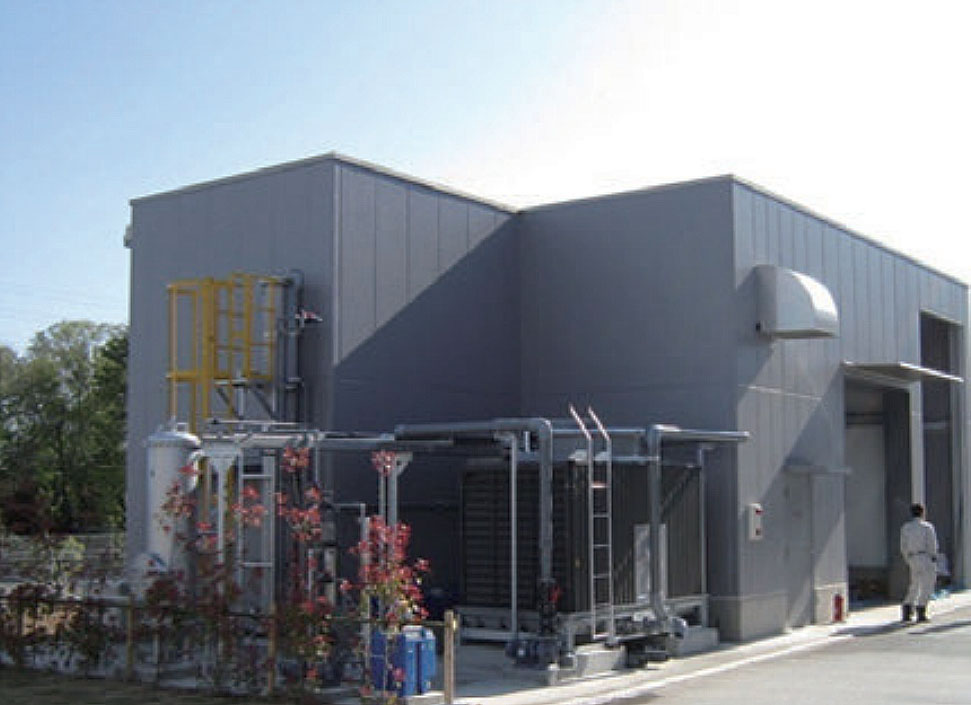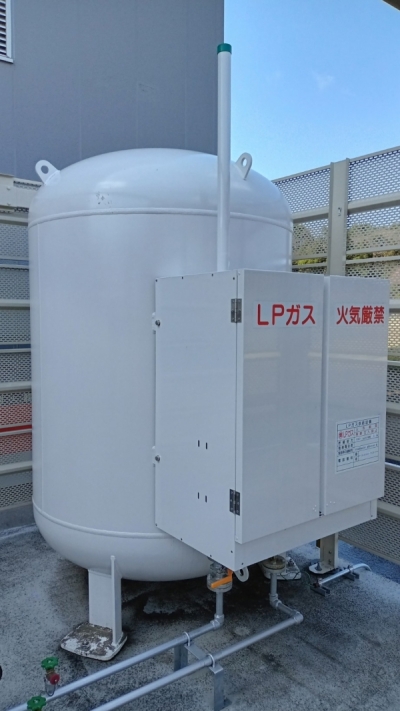Measures to Reduce Environmental Impact
Environmental impact of production activities
We’re ascertaining and striving to minimize the overall environmental impact of our production activities.
Environmental impact
CO2 Emissions Intensity
Also known as the CO2 emissions coefficient, CO2 emissions intensity refers to the volume of CO2 emitted from a fixed amount of business activities. We calculate CO2 emissions intensity by dividing CO2 emissions converted from electricity, natural gas, and other energy needed in manufacturing using fixed coefficients by plant processing volume. This is used as a general indicator of energy conservation because it is unaffected by changes in sales or production volume.
Four plants (per yen of processing)
| 2019 | 2020 | 2021 | 2022 | 2023 | 2024 | |
|---|---|---|---|---|---|---|
| Four plants (per yen of processing) | 1.80 | 1.99 | 2.02 | 2.08 | 1.68 | 1.70 |
Quantitative Changes
The head office, Sales Group, and four plants are striving to conserve energy through means such as adopting high-fficiency equipment. We’re also striving to reduce industrial waste and increase recycling rates. Although industrial waste emissions increased in FY2024, recycling rates improved to 99.6%.
Electricity use
| 2021 | 2022 | 2023 | 2024 | ||
|---|---|---|---|---|---|
| Four plants | Osaka Plant | 10,330 | 11,784 | 11,801 | 11,296 |
| Tokyo Plant | 6,993 | 7,771 | 8,083 | 9,597 | |
| Nara Plant | 3,893 | 3,782 | 3,446 | 3,330 | |
| Ibaraki Plant | 2,213 | 2,405 | 2,396 | 2,360 | |
| Total | 23,429 | 25,741 | 25,726 | 26,583 | |
| Headquarters and sales as a whole | 803 | 802 | 1,013 | 1,052 | |
| Companywide | Total | 24,232 | 26,543 | 26,739 | 27,635 |
Recycling of industrial waste
Each plant recycles as much industrial waste as possible in an effort to reduce the amount of waste ultimately disposed of. Part of the industrial waste from the loss of manufacturing paper and chemical product packaging, and part of the packaging materials that were used as raw and subsidiary materials are now reused in the market as recycled packaging materials, etc. Some industrial waste that cannot be recycled is recycled into solid fuels and other useful resources.
- Industrial waste such as used paper and polythene film is recycled and reused.
Volume of industrial waste recycled
| 2021 | 2022 | 2023 | 2024 | ||
|---|---|---|---|---|---|
| Four plants | Osaka Plant | 5,430 | 5,605 | 5,882 | 5,682 |
| Tokyo Plant | 4,845 | 4,546 | 4,645 | 5,348 | |
| Nara Plant | 7,681 | 7,381 | 6,239 | 5,916 | |
| Ibaraki Plant | 388 | 381 | 378 | 317 | |
| Total | 18,344 | 17,913 | 17,144 | 17,263 |
Recycling rate
| 2021 | 2022 | 2023 | 2024 | ||
|---|---|---|---|---|---|
| Four plants | Osaka Plant | 99.1 | 99.1 | 95.0 | 98.9 |
| Tokyo Plant | 100 | 99.9 | 99.9 | 99.9 | |
| Nara Plant | 99.9 | 99.9 | 99.9 | 99.9 | |
| Ibaraki Plant | 99.9 | 99.9 | 99.9 | 99.9 | |
| Total | 99.7 | 99.7 | 98.2 | 99.6 |
Final waste treatment volume
| 2021 | 2022 | 2023 | 2024 | ||
|---|---|---|---|---|---|
| Four plants | Osaka Plant | 48 | 49 | 308 | 63 |
| Tokyo Plant | 7 | 4 | 2 | 2 | |
| Nara Plant | 7 | 7 | 7 | 7 | |
| Ibaraki Plant | 0 | 0 | 0 | 0 | |
| Total | 63 | 60 | 317 | 72 |
Appropriate Management of Chemical Substances
The chemical substances we use in manufacturing processes are suitably managed pursuant to the Act on Confirmation, etc. of Release Amounts of Specific Chemical Substances in the Environment and Promotion of Improvements to the Management Thereof (PRTR Act). In addition, in bag and carton production, we are making steady progress on switching to safe adhesives free of restricted chemical substances. In FY2024, the volume of substances subject to the PRTR Act remained unchanged year-on-year.
Volumes of Type I designated chemical substances under the PRTR Act (total for all four plants)
| Subject chemical substances | Material in which included | 2021 | 2022 | 2023 | 2024 |
|---|---|---|---|---|---|
| Toluene | Adhesives | 0.0 | 0.0 | 0.0 | 0.0 |
| Xylene | Adhesives | 0.0 | 0.0 | 0.0 | 0.0 |
| Phthalates | Adhesives | 0.0 | 0.0 | 0.0 | 0.0 |
| Boric acid and compounds thereof | Adhesives | 1.6 | 1.4 | 1.2 | 1.2 |
| Monochlorobenzene | Adhesives | 0.0 | 0.0 | 0.0 | 0.0 |
| Dichloromethane | Offset-printing cleaning solution | 0.0 | 0.0 | 0.0 | 0.0 |
| 1,2-Dichloropropane | Offset-printing cleaning solution | 0.0 | 0.0 | 0.0 | 0.0 |
| Total | 1.6 | 1.4 | 1.2 | 1.2 | |
Putting Water Resources to More Effective Use
The water used at the Tokyo Plant for washing printing ink, paint, and adhesives in the manufacturing process is recycled using a water treatment facility for use as toilet flushing water. This helps conserve tap water and counters water shortages by making more efficient use of our limited water resources.

Fuel conversion at the Ibaraki Plant
In 2024, the Ibaraki Plant upgraded its aged kerosene boilers, replacing them with eco-friendly LPG (liquefied petroleum gas) boilers. Since LPG is a clean energy source that when burned emits almost no substances harmful to the environment or people, the fuel conversion is expected to reduce emissions of substances that lead to global warming and acid rain. The decision to convert to LPG fuel was made not just to reduce CO2 emissions but to cut costs.
As a result, CO2 emissions per boiler at the Ibaraki Plant in 2024 were down 56 t (24%) year-on-year, while operating costs fell by 11%.
The LPG boilers allow safe energy use. For example, they eliminated the risk of soil or groundwater pollution from kerosene leaks.

Eco-friendly Printing Ink
We offer a full lineup of eco-friendly printing ink for use with packaging materials. This makes it possible to contribute to a carbon-zero society by switching from ordinary inks, made using petroleum-based compound resins and organic solvents, to inks made from biomass materials and water-based inks that use no organic solvents.
Eco-friendly Printing Plastic Bags
To reduce use of petroleum-based compound resins in plastic bags, we’re expanding our lineup of biomass materials. We currently offer 13 types of products that have earned biomass mark certification from the Japan Organics Recycling Association.
Participation in CLOMA
There are calls worldwide to promote efforts to identify solutions for the issue of ocean plastic waste, a new issue recognized on a global scale. In response, the Japan Clean Ocean Material Alliance (CLOMA) was launched in January 2019 to promote innovation by strengthening joint efforts among a wide range of parties across industry boundaries and by pooling their technologies and expertise. Since then, we’ve participated in CLOMA’s activities as a core member, mainly by proposing use of paper materials as alternatives to plastic products. We plan to maintain our efforts in related areas, including developing new eco-friendly packages and building systems to help realize a circular economy by exchanging information and working with other CLOMA members.